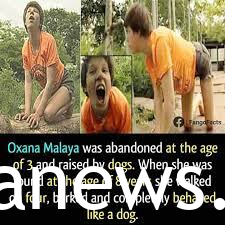Oxana Malaya: In the annals of extraordinary human stories, few are as captivating and heart-wrenching as that of Oxana Malaya. Born in Ukraine in 1983, Oxana’s life took a bizarre turn when she was abandoned by her parents at the tender age of three. Left to fend for herself in the wild, Oxana found an unlikely family in a pack of dogs. Her remarkable story sheds light on the indomitable human spirit and the innate capacity for survival.

The Fateful Abandonment:
Oxana’s tale begins with a tragic abandonment. Her parents, dealing with their own struggles, left her outside one cold night, where the curious pack of dogs discovered the helpless toddler. In a twist of fate, the dogs adopted Oxana as one of their own, providing her with a semblance of protection and companionship.
Life Among Canines:
For six long years, Oxana lived in the company of the dogs, adopting their behaviors and mannerisms. She learned to walk on all fours, barked like her adoptive siblings, and scavenged for food just as they did. The dogs, in turn, accepted her as part of their pack, forming an unconventional family dynamic in the heart of the Ukrainian wilderness.
Discovery and Rehabilitation:
Oxana’s story came to light in 1991 when a neighbor stumbled upon the wild child living with dogs. Shocked by the discovery, authorities intervened and placed Oxana in the care of a social institution. The transition from a feral existence to a structured human environment proved challenging for Oxana, who struggled to adapt to societal norms and behaviors.

11 Fascinating Facts about Oxana Malaya:
1. Age of Discovery:
Oxana Malaya was discovered in 1991 at the age of eight, marking the end of her six-year feral existence with the dogs.
2. Language Barrier:
Due to her upbringing, Oxana initially communicated through barks and growls, lacking the ability to speak or understand human language.
3. Wild Habits:
Oxana displayed feral behaviors such as walking on all fours, eating raw meat, and exhibiting a lack of social etiquette.
4. Rehabilitation Challenges:
The process of reintegrating Oxana into human society was a formidable challenge, as she struggled with basic human interactions and lacked essential life skills.
5. Psychological Impact:
Oxana’s experiences with the dogs left a lasting psychological impact, making it difficult for her to form emotional connections with humans.

6. Educational Endeavors:
Despite her challenging background, Oxana embarked on a journey of education, learning to read and write with the support of dedicated caregivers.
7. Life Beyond the Headlines:
Oxana’s story gained international attention, but she eventually retreated from the public eye, seeking a more private and normal life.
8. Human Relationships:
Over time, Oxana managed to form relationships with humans, challenging the initial skepticism about her ability to adapt to conventional social norms.
9. The Importance of Social Support:
Oxana’s rehabilitation emphasized the crucial role of social support in helping individuals overcome the traumas of a feral existence.
10. Inspiration for Researchers:
Oxana’s case has been studied by psychologists, anthropologists, and researchers interested in understanding the effects of extreme isolation on human development.
11. Legacy of Resilience:
Today, Oxana’s story stands as a testament to the human spirit’s resilience and the power of compassion in overcoming even the most challenging circumstances.

Conclusion:
Oxana Malaya’s journey from a feral child raised by dogs to a woman navigating the complexities of human society is a testament to the resilience of the human spirit. Her story serves as a reminder of the importance of compassion, understanding, and support in helping individuals overcome the most extraordinary challenges life may throw their way. Oxana’s life continues to inspire researchers, educators, and those fascinated by the indomitable strength that resides within us all.
WRITTEN BY ALEX
FAQs and answers
1. Who is Oxana Malaya?
Oxana Malaya is a Ukrainian woman known for being a feral child. She was found living with dogs in 1991 after spending several years of her early childhood in a kennel. Due to severe neglect, she exhibited canine-like behaviors and struggled with human socialization.
Source
2. How did Oxana Malaya end up living with dogs?
Oxana’s parents were alcoholics who neglected her. At the age of three, she was left outside and sought warmth in a dog kennel. Over the years, she adapted to the dogs’ way of living, imitating their behavior, including barking, running on all fours, and eating raw meat.
Source
3. What were Oxana Malaya’s behaviors when she was discovered?
When she was found at age eight, Oxana walked on all fours, barked, and had difficulty speaking. She exhibited many behaviors similar to those of dogs, such as growling and sniffing. However, after years of therapy, she regained some human abilities.
Source
4. Did Oxana Malaya ever recover from her feral state?
Yes, to some extent. After being rescued, she underwent therapy and was taught human behavior, including speech and social interaction. While she was able to regain many human traits, she still struggles with deep emotional connections.
Source
5. Where is Oxana Malaya now?
As of recent reports, Oxana Malaya lives in a care facility for adults with special needs in Ukraine. She works on a farm and has a relatively stable life but remains under professional care due to her early trauma.
Source
6. Is Oxana Malaya the only documented case of a feral child?
No, there have been several cases of feral children throughout history, such as Victor of Aveyron in France and Genie in the United States. However, Oxana’s case is unique due to the extent of her adaptation to canine behaviors.
Source
7. What does Oxana Malaya say about her past now?
In interviews, Oxana has expressed that she understands her past but prefers not to dwell on it. She has stated that she enjoys working with animals and finds comfort in their company.
Source

